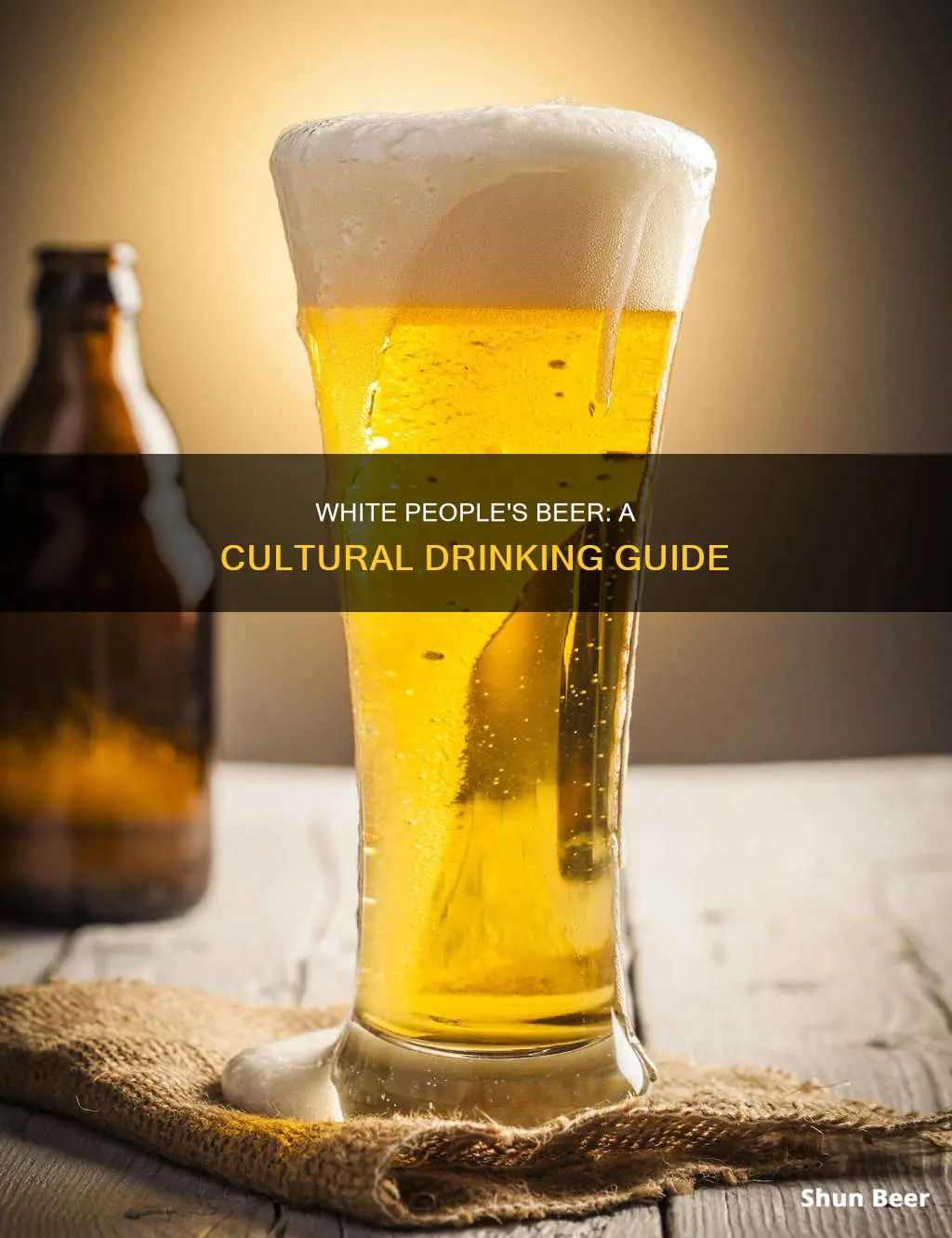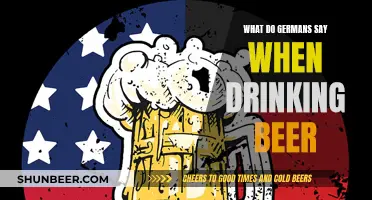
The topic of beer consumption and production among different racial groups in the United States has been a subject of interest and debate. While the beer industry in the US has historically been predominantly white, there are complex cultural, social, and economic factors that influence drinking patterns and preferences across different racial groups.
One notable aspect is the lower consumption of craft beer among Black Americans. According to a 2014 Nielsen survey, Black Americans drank only 3.7% of all craft beer in the country, despite comprising 11.2% of the population. This disparity has sparked discussions about the role of racism, cultural norms, and economic factors in shaping drinking habits. Some suggest that the whiteness of craft beer culture may deter Black drinkers and brewers, perpetuating racial inequality. Others argue that drinking preferences are influenced by a combination of factors, including regional differences, economic status, and social norms.
Additionally, studies have explored the relationship between alcohol consumption patterns and mortality rates among different racial groups. One study found that Black men who abstained from alcohol had the lowest mortality risk, while moderate consumption patterns resulted in the lowest risk for White men. Among women, White women who consumed one drink per day on 3 to 7 days per week and Black women who drank less frequently had the lowest mortality risk. These findings highlight potential racial differences in the health impacts of alcohol consumption.
The discussion around beer consumption and production among racial groups is complex and multifaceted, involving historical context, cultural norms, and socioeconomic factors that shape drinking habits and preferences.
What You'll Learn

Craft beer is largely consumed by white people
Firstly, it is important to note the history of racism in the beer industry. The Prohibition movement in the US was "always racialized", with political cartoons depicting Black people as willing minions of a Germanic beer baroness. After Prohibition, the consolidation of beer brewing into very large corporations likely hurt minority groups who would have potentially owned breweries. Additionally, there is a long history of discrimination against African-Americans in the brewing industry, with brewing companies in the 1950s telling the Urban League that there was "no place for African-Americans, skilled or unskilled, in our breweries". This legacy of racism has resulted in a lily-white talent pool in the beer industry, which has been perpetuated by the fact that craft brewing requires money and time – two things that Black Americans often have less of than their white counterparts.
Another reason for the popularity of craft beer among white people is the culture surrounding it. Craft beer has become associated with a particular image: a white guy with a beard, swilling beer in specialty stemware, in an "authentic" bar in a gentrified neighborhood. This image is off-putting to many Black people, who feel that craft beer culture is not welcoming or inclusive. Additionally, there are often fewer craft beer bars, restaurants, and stores in Black neighborhoods.
Finally, it is important to consider the economic arguments. Craft beer tends to be more expensive than other types of beer, and people of color tend to have far less income than their white counterparts. This may lead to people of color opting for cheaper options, such as a case of beer from the local gas station, rather than a $20 six-pack of craft beer.
While there are a variety of reasons for the disparity in craft beer consumption between white and Black people, it is clear that craft beer is largely consumed by white people. This lack of diversity in the craft beer community is an issue that needs to be addressed, in order to create a more inclusive and welcoming environment for people of all races.
Mexican Beer: What's in the Glass?
You may want to see also

Black people are underrepresented in the beer industry
The lack of representation in the beer industry can be attributed to various factors, including historical racism, economic barriers, and cultural norms. Racism and years of systematic oppression have created hurdles for Black Americans seeking business development and expansion, with Black Americans and Hispanics being less likely to be approved for business loans and receiving smaller amounts when they are approved. This wealth gap makes it difficult for Black entrepreneurs to break into an industry that requires significant capital investment.
Additionally, the beer industry has been predominantly white in its marketing and cultural representation. The image of craft beer, in particular, is associated with white, bearded men, giving the industry a "hilariously white" appearance. This perception is further reinforced by the predominantly white staff and clientele in craft breweries and the lack of diverse representation in beer advertising.
The drinking preferences of Black Americans also contribute to their underrepresentation in the beer industry. Black Americans tend to consume less alcohol overall and have lower alcohol spending compared to their white counterparts. Cultural and religious factors play a role as well, with alcohol consumption sometimes viewed negatively within the Black community.
To address these issues, initiatives such as Fresh Fest, the country's first Black beer festival, and Black Brew Culture, an online magazine showcasing Black brewers, have been launched. These efforts aim to increase the visibility of Black brewers, promote their creations, and foster a more inclusive environment for drinkers of all backgrounds.
Non-Alcoholic Beer: Safe, Sensible, and Socially Acceptable?
You may want to see also

Black people are less likely to drink alcohol
Economic factors
Black people in the US tend to have lower incomes than their white counterparts. Craft beer is expensive, with a six-pack costing up to $20. This means that people of colour, who generally have less disposable income, are less likely to be able to afford craft beer.
Social factors
The Black American cookout is a sacred institution with its own set of sacred rules. Beer, though, is another question entirely. Heineken, Corona, and Bud Heavy are the most likely beers to be found at a cookout, while craft beer is generally scorned.
Regional factors
In the South, people tend to drink lighter beers due to the hot weather. Older Black Americans in the South are comfortable drinking regular light beers.
Cultural factors
Alcohol is sometimes seen as a stigma in the Black community. This is partly due to the influence of the Black church, which often frowns upon drinking.
Beer and Amoxicillin: Is It Safe to Drink?
You may want to see also

Black people face barriers to entering the craft beer industry
The craft beer industry is overwhelmingly white, and Black people face significant barriers to entering the industry. Systemic racism, lack of representation, and economic factors all contribute to the lack of diversity in craft beer brewing.
One of the main barriers is economic inequality. Black Americans have less wealth, lower incomes, and face more challenges in obtaining bank loans than their white counterparts. This makes it difficult for aspiring Black brewers to obtain the necessary capital to start a craft brewery, which requires a significant financial investment. The high cost of craft beer can also be a barrier for Black consumers, who have lower disposable incomes and may opt for cheaper alternatives.
Systemic racism and discrimination within the industry also play a significant role. Historically, the brewing industry has excluded and discriminated against Black people, both as employees and consumers. This legacy of racism has persisted, with Black people facing barriers to employment and business ownership due to discriminatory practices and a lack of representation in leadership and ownership roles.
The lack of representation and marketing towards Black consumers further contributes to the disparity. Craft beer has largely been marketed towards white consumers, with few efforts to engage and include Black drinkers. This has resulted in a disconnect between the craft beer industry and the Black community, perpetuating the perception that craft beer is predominantly white.
Additionally, cultural and regional factors influence drinking preferences. Black communities have their own drinking traditions and preferences, which may differ from the craft beer offerings. Regional factors, such as climate and local specialties, also play a role in drinking choices.
It is important to note that the issue of diversity in the craft beer industry is not simply about the number of Black brewers or consumers, but also about addressing broader issues of racial inequality and representation. Efforts to increase diversity and inclusion in the industry can help create a more equitable and welcoming environment for Black people to participate and thrive.
Despite these challenges, there are notable Black brewers and entrepreneurs who are making strides in the industry. Initiatives such as Fresh Fest, the country's first beer festival devoted to Black-owned breweries, and organizations like Crafted For All, which works for equity and inclusion in the industry, are helping to address these barriers and create a more diverse and inclusive craft beer culture.
Beer: A Singer's Remedy or Vocal Cord Myth?
You may want to see also

Craft beer is marketed towards white people
The craft beer industry has been criticised for its lack of diversity, with the majority of brewers, bar owners, bloggers, and aficionados being white. This is despite the fact that Black Americans have a long history of brewing beer, dating back to the 19th century.
There are several reasons why craft beer is marketed towards white people. Firstly, the industry has a history of racism and discrimination, with Black brewers facing barriers to entry such as difficulty securing bank loans and finding investors. Additionally, craft brewing requires a significant amount of money and time, which can be out of reach for many Black Americans due to the wealth gap and systemic racism.
The marketing and imagery of craft beer also play a role in its appeal to predominantly white consumers. The founders, staff, and clientele of craft breweries tend to be white, and the industry often promotes itself as a "kinder, gentler alternative" to large corporations, while failing to address its own issues with diversity and inclusion. The marketing often centres on stories of white artisans and entrepreneurs, erasing the contributions of people of colour to the brewing industry.
Furthermore, craft beer has been criticised for its "hipster" culture, which can be off-putting to potential Black consumers. The craft beer community has been described as "white guys with beards making beer", and the high prices of craft beer can be a barrier for people of colour, who statistically have lower incomes.
Lastly, the lack of representation in the craft beer industry may contribute to its lack of appeal to people of colour. With few Black brewers, bar owners, and bloggers, the industry fails to reflect the diversity of its potential consumer base. This lack of representation can perpetuate the cycle of craft beer being marketed towards and consumed by predominantly white people.
While there have been some efforts to address the lack of diversity in the craft beer industry, such as collaborations and initiatives highlighting the issue, it is clear that more needs to be done to make the industry more inclusive and representative.
Germans and Their Beer: Warm or Cold?
You may want to see also
Frequently asked questions
Yes, according to a 2014 Nielsen survey, 80% of craft beer in the US is consumed by white drinkers, who make up 60% of the population.
There are a few reasons for this. Firstly, craft beer is expensive, and white Americans tend to have higher incomes than their non-white counterparts. Secondly, the American beer industry has historically been white, and the talent pool for craft beer sprang from this overwhelmingly white industry. Finally, craft beer culture is often perceived as exclusionary to non-white drinkers.
Yes, according to a 2013 survey by the US Department of Health and Human Services, 57% of white Americans reported current alcohol use, compared to just 43% of African Americans.
It depends. Some studies suggest that moderate alcohol consumption may have health benefits for white men and women, but not for their non-white counterparts. However, it's important to note that excessive alcohol consumption is associated with harmful health effects for all racial groups.
Popular beer brands among white drinkers include Budweiser, Miller, Coors, Heineken, Corona, and craft beers such as IPAs.







